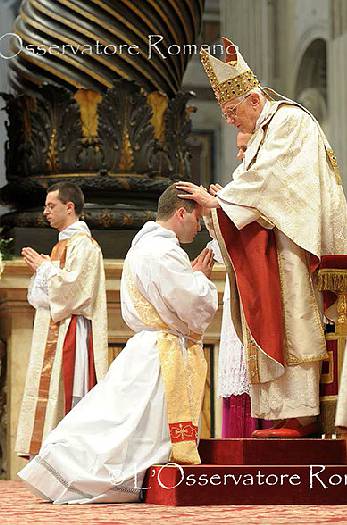Den hellige Josefs viktigste minnedag er 19. mars, men katolsk.no skriver om hvorfor han også feires 1. mai:
… Den salige pave Pius IX utnevnte ham i 1870 til «Universalkirkens beskytter», og oppmuntret også hans «patronatsfest», senere «høytidsdag», på tredje onsdag etter påske. Denne festen ble erstattet av pave Pius XII i 1955 med en fest den 1. mai for St. Josef, «arbeideren», senere «håndverkeren», innført som en motvekt mot sosialistenes feiring av dagen. …
Noen år fram til 1969 ble denne dagen feiret som fest av 1. klasse, men ble så kraftig nedgradert til valgfri minnedag. Men dagen har en fullt utarbeidet messe også i den nye kalenderen, og det er vel meningen å feire han ganske skikkelig alle steder 1. mai er arbeidernes dag – dvs. de fleste steder utenom USA.
Siden det er fest av 1. klasse i den tradisjonelle kalenderen, har matutin hele 9 lesninger. Lesning 1, 2 og 3 er fra 1. Mosebok og handler om skapelsen og menneskets oppdrag: Gen 1:27-28,31; 2:1-3 – Gen 2:7-9,15 – Gen 3:17-19, 23-24
Lesningene 4, 5 og 6 er fra the Acts of Pope Pius XII
The Church, most provident Mother of All, expends the greatest efforts for the protection and relief of the workers, erecting and promoting for them societies which Pius XII, the Supreme Pontiff, now wishes to be entrusted to the most powerful patronage of St. Joseph. For St. Joseph, since he was reckoned the father of Christ, who deigned to be called the son of a workman, on account of the irrevocable bond which united him to Jesus, drank abundantly of that spirit which ennobles and elevates labor. In like manner, associations of workers ought to be aware of the same kind of spirit, so that Christ may always be present in them, in their members, in their families and in fact in every labor organization, because the chief purpose of these associations is to foster and nourish the Christian life in their members, to spread the Kingdom of God more widely, especially among fellow workers in the same plant.
The same Pontiff supplied a new proof of the Church’s solicitude for labor organization, when, upon the occasion of a convention of workingmen held in Rome on the first of May in the year 1955, he took the opportunity of speaking to a large multitude gathered in the square before St. Peter’s Basilica, and commended most highly the instruction of workingmen. For in our day it is of prime importance that the workers be properly imbued with Christian doctrine in order that they may avoid the widespread errors concerning the nature of society and economic matters. Moreover, such instruction is needed that they might have a correct knowledge of the moral order established by God as it effects the rights and duties of workers, and which the Church discloses and interprets, so that by partaking in the needed reforms they might work more effectively toward their realization. For Christ was the first one to promulgate in the world those principles which he delivered to the Church and which still stand unchangeable and most valid for the solution of these problems.
In order that the dignity of human labor and the principles which underlie it might penetrate more deeply into souls, Pius XII has instituted the feast of St. Joseph the Workman, as an example and a protection for all associations of workers. For from this example, those who follow the worker’s calling ought to learn how and in what spirit they should discharge their duties, so that, obeying the first law of God, they might likewise subdue the earth and attain to economic prosperity, and at the same time reap the rewards of eternal life. Nor will the prudent guardian of the Family of Nazareth fail to shield with his protection, and from heaven bless the homes of those who, like him, are artisans and workmen. Most aptly has the Supreme Pontiff ordered this feast to be celebrated on the first of May, a day which the workers have adopted as their own; from henceforth let it be hoped that this day, dedicated to St. Joseph the Workman, will, as time goes on, not sharpen hatred and inflame strife, but with each recurring year, invite everyone to strive more and more for those things which are still lacking to civil peace, and indeed that it may stimulate the public authorities to use their abilities in effecting whatever right order demands of human fellowship.
Lesning 7, 8 og 9 er en preken av den hellige Albert den store over evenagelieteksten på denne dagen; Mat. 13:54-58, som også brukes som evangelium i den nye messen:
På den tid kom Jesus til sin hjembygd og underviste folk i synagogen der, slik at de undret seg stort og sa: «Tro hvor han har denne visdommen fra, og denne undergjørende kraften? Det er da sønnen til tømmermannen? Og heter kanskje ikke hans mor Maria og hans brødre Jakob og Josef og Simon og Judas? Og søstrene hans, bor de ikke her blant oss alle sammen? Hvor kan han da ha alt dette fra?» Og de festet ingen lit til ham. Jesus sa da til dem: «Bare i sitt hjem og i sin hjembygd blir en profet ringeaktet slik.» Og på grunn av deres vantro var det ikke mange under han gjorde der.


 Dette satte
Dette satte